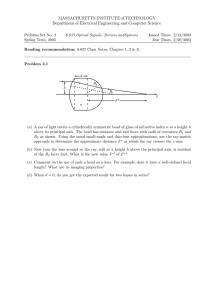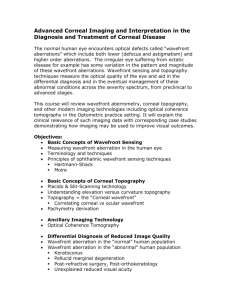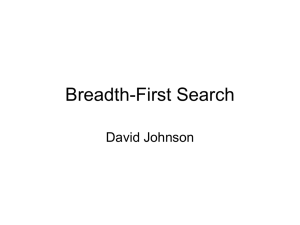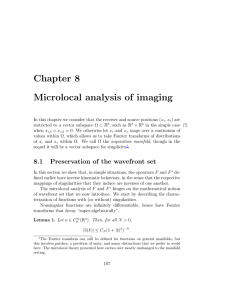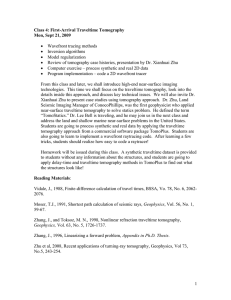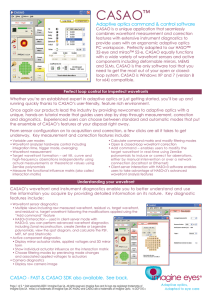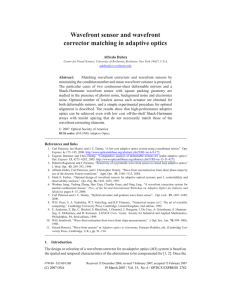Navigation and Metric Path Planning (con’t) September 30, 2014
advertisement
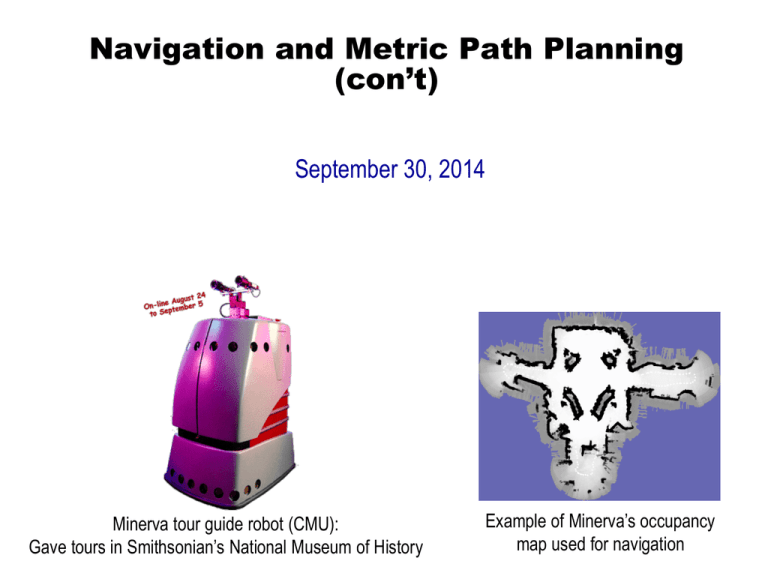
Navigation and Metric Path Planning (con’t) September 30, 2014 Minerva tour guide robot (CMU): Gave tours in Smithsonian’s National Museum of History Example of Minerva’s occupancy map used for navigation Path Planning Summary (so far) 1. Construct configuration space (by growing obstacles) 2. Select representation: either graph (sometimes called “roadmap”) or cell decomposition (or potential fields -- we’ll study these next) • Graph (“roadmap”) construction – • Identify a set of routes within the free space Alternative approaches: – – – Meadow maps Generalized Voronoi graphs Visibility graphs • Cell decomposition – Discriminate between free and occupied cells • Variants: – Regular grids – Quadtree grids (also called “adaptive” and “variable cell” decomposition in your text) – Exact cell decomposition Path Planning Summary (so far) 3. Plan path • Common algorithms: – – A*: Typically used for graph-based methods Wavefront path planning (which your text also calls “NF1” and “grassfire”): Typically used in cellular decomposition methods Additional Graph-Based Representation: Visibility Graph • Approach: Connect all vertices that are “visible” to each other – Advantage: Can generate optimal shortest paths (based on path length) – Disadvantage: Can cause robot to move too closely to obstacles (solution: grow obstacles even more, to give more open space between robot and obstacle) Additional Cell Decomposition: Exact Cell Decomposition (Similar to Meadow Map) Approach: • Divide space into simple, connected regions called cells • Determine which open cells are adjacent and construct a connectivity graph • Find cells in which the initial and goal configuration (state) lie and search for a path in the connectivity graph to join them. • From the sequence of cells found with an appropriate search algorithm, compute a path within each cell. – e.g. passing through the midpoints of cell boundaries or by sequence of wall following movements. Algorithms • For Path planning – A* for relational graphs – Wavefront for operating directly on regular grids A* Search Algorithm • Similar to breadth-first: at each point in the time the planner can only “see” its node and 1 set of nodes “in front” • Idea is to rate the choices, choose the best one first, throw away any choices whenever you can: f*(n) = g*(n) + h*(n) where: // ‘*’ means these are estimates • f *(n) is the “goodness” of the path from Start to n • g*(n) is the “cost” of going from the Start to node n • h*(n) is the cost of going from n to the Goal – h is for “heuristic function”, because must have a way of guessing the cost of n to Goal since can’t see the path between n and the Goal A* Heuristic Function f *(n) = g*(n) + h*(n) • g*(n) is easy: just sum up the path costs to n • h*(n) is tricky – But path planning requires an a priori map – Metric path planning requires a METRIC a priori map – Therefore, know the distance between Initial and Goal nodes, just not the optimal way to get there – h*(n)= distance between n and Goal Estimating h(n) • Must ensure that h*(n) is never greater than h(n) • Admissibility condition: – Must always underestimate remaining cost to reach goal • Easy way to estimate: – Use Euclidian (straight line) distance – Straight line will always be shortest path – Actual path may be longer, but admissibility condition still holds Pros and Cons of A* Search/Path Planner • Advantage: – Can be used with any Cspace representation that can be transformed into a graph • Limitation: – Hard to use for path planning when there are factors to consider other than distance (e.g., rocky terrain, sand, etc.) Extension to A* = D* • D*: initially plans path to goal just like A*, but plans a path from every position to the goal in advance – I.e., rather than “single source shortest path” (Dijkstra’s algorithm), • Solve “all pairs shortest path” (e.g., Floyd-Warshall algorithm) • In D*, the estimated distance, h*, is based on traversability Calculate traversability using stereo cameras; can also manually mark maps • Then, D* continuously replans, by updating map with newly sensed information – Approach: “repair” pre-planned paths based on new information D* Applied to Mars Rover “Opportunity” Rover “Opportunity” Image of Victoria crater, taken by rover “Opportunity” Victoria crater, on Mars Wavefront-Based Path Planners • Well-suited for grid representations • General idea: consider Cspace to be conductive material with heat radiating out from initial node to goal node • If there is a path, heat will eventually reach goal node • Nice side effect: optimal path from all grid elements to the goal can be computed • Result: map that looks like a potential field Example of Wavefront Planning Goal Start Algorithmic approach for Wavefront Planning Part I: Propagate wave from goal to start • Start with binary grid; 0’s represent free space, 1’s represent obstacles • Label goal cell with “2” • Label all 0-valued grid cells adjacent to the “2” cell with “3” • Label all 0-valued grid cells adjacent to the “3” cells with “4” • Continue until wave front reaches the start cell. Part II: Extract path using gradient descent • Given label of start cell as “x”, find neighboring grid cell labeled “x-1”; mark this cell as a waypoint • Then, find neighboring grid cell labeled “x-2”; mark this cell as a waypoint • Continue, until reach cell with value “2” (this is the goal cell) Part III: Smooth path • Iteratively eliminate waypoint i if path from waypoint i-1 to i+1 does not cross through obstacle • Repeat until no other waypoints can be eliminated • Return waypoints as path for robot to follow Wavefront Propagation Can Handle Different Terrains • Obstacle: zero conductivity • Open space: infinite conductivity • Undesirable terrains (e.g., rocky areas): low conductivity, having effect of a high-cost path • Also: To save processing time, can use dual wavefront propagation, where you propagate from both start and goal locations Example Using Dual Wavefront Propagation 10 Iterations 30 Iterations Dual Wavefront Propagation in Progress 50 Iterations 70 Iterations Dual Wavefront Propagation in Progress (con’t.) 90 Iterations 110 Iterations Dual Wavefront Propagation in Progress (con’t.) Propagation complete. Extracted Path Goal position Starting position
